What is Search Intent & How To Optimize for It in SEO
Key Takeaways
- Understanding search intent helps create specific content tailored to users' expectations when they search online.
- Search intent guides content creation by ensuring that the right resources are provided to address users' needs at the right time.
- Google emphasizes satisfying user needs by focusing on search intent and different types of queries users may have.
Search intent (or the user intent) is the result that people anticipate when they type in a query in search engines. It represents their frustrations and what they expect to get in response to their search query.
Why?
Web users always turn to search engines (like Google) to find relevant answers to their questions. And the only way you can create specific content that meets their expectations is to understand the intent behind their search.
For example, a user who is googling “yoga poses for beginners” needs resources on how to improve their poses. But more than this, it’s obvious that they’re new to yoga, and they need more resources for their fitness journey.
This means that aside from optimizing your page with yoga poses, your content would be more helpful if it contains links to other pages (on your website) that are resources to guide a beginner through their fitness journey. These could be resources such as pre- or post-workout stretch routines or diet options for good health.
Because of the nuances of search intent, understanding it goes beyond interpreting the literal meaning of a query or the keyword you found on keyword research tools.
Why is Search Intent Important?
Every content should be written with the audience in mind, and the only way to know what they need is to understand user intent. Search intent in SEO also helps you:
1. Publish the Right Content at the Right Time for the Right Audience:
Google emphasizes user intent as much as it emphasizes meeting E-E-A-T guidelines. In their PDF Search Quality Evaluator Guidelines, they dedicated a whole section to exploring search intent types and the nuances different types of queries could have.
Google emphasizes search intent based on the need for content that satisfies users’ needs. If you google “time in California now,” you’ll see a straightforward result showing the time. It doesn’t direct you to a blog post about luxury wristwatches or flight times to California based on your location.
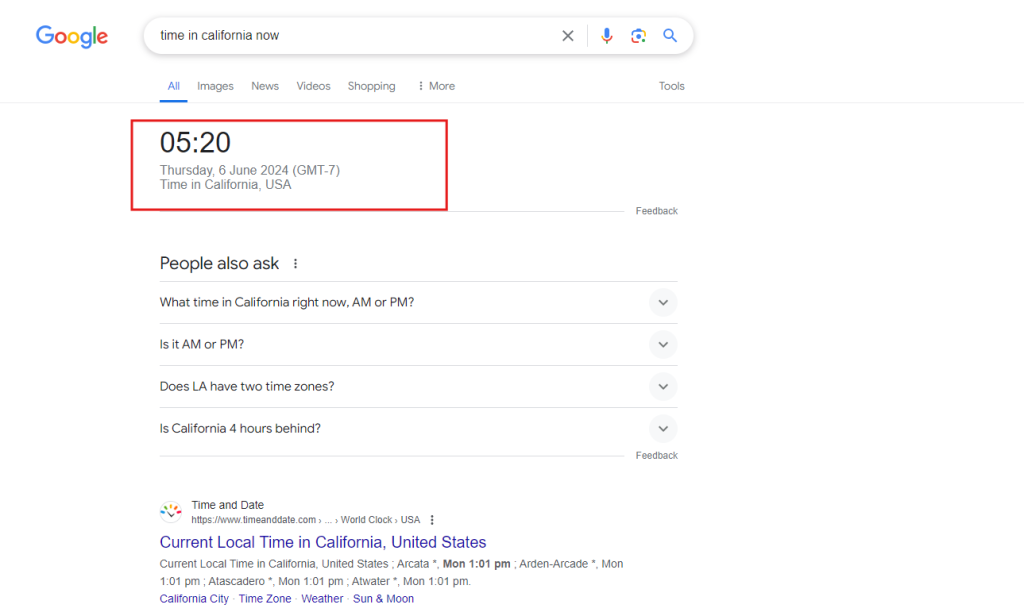
In this way, Google provides the right content at the right time for the right audience— based on the intent of their request. And Google wants you to do the same.
If a user searches for “how to fix a leaky faucet,” your HVAC landing page or product pages about plumbing tools will not rank— the intent doesn’t match. Instead, these blog articles and YouTube videos are what matches the intent of the user:
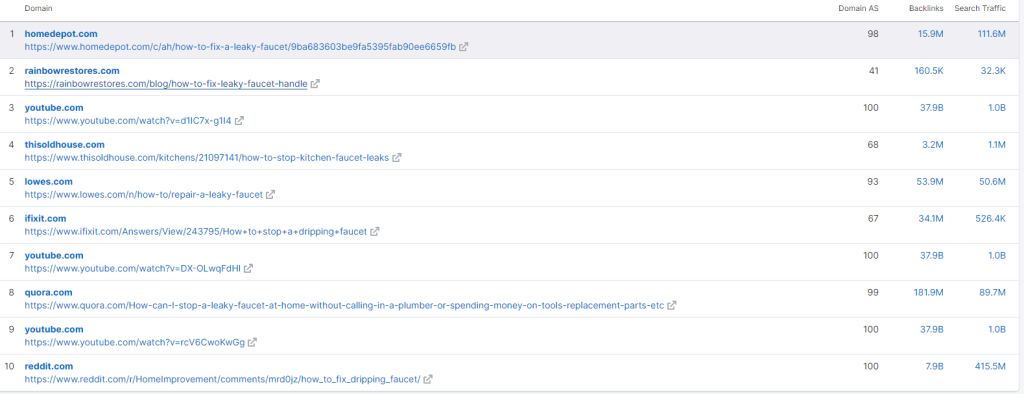
So, understanding search intent ensures that every piece of content not only meets but exceeds the expectations of your target audience. Achieving this can lead to increased visibility and relevance in search results.
2. Increase User Engagement and Conversion:
Since your content reflects what users expect to read, it’s easy to “charm them” to stay longer on your page and potentially take a desired action, especially if they trust you. Here’s what I mean:
When your content meets their needs, they won’t be compelled to leave your website as fast as they clicked on it. And the longer they stay on your page consuming your content, the better.
Staying longer signals to Google that your content is helpful. It also increases the engagement rate and the potential to convert some of these visitors.
Therefore, search intent is key to keeping users who click to read your content engaged with the content.
3. Create an Effective Content Strategy:
Every content strategy, especially when it comes to content ideas, should prioritize search intent. One way to do this is to shift focus from pursuing high-volume keywords to high-intent keywords. These keywords demonstrate strong user intent to take action, even if they have lower search volumes.
For example, if you’re a dealer of high-end watches, it’s better to target the query “luxury watches for investment” rather than “luxury watches.” The latter has more search volume, but most of the traffic you’ll attract is generally luxury watch lovers, not those with the capital to invest in watches.
After all, every content strategy aims to create content that converts.
So, by narrowing down every keyword (or content idea) and analyzing the intent behind those keywords, you’ll improve your chances of creating content that matches users’ expectations and achieves your intended results. These intended results could be sign-ups, newsletter subscriptions, or sales.
The Four Types of Search Intent
There are four main types of search intent:
- Informational Intent: These users want answers to their questions (e.g., “how to bake bread” or “symptoms of the flu”). Content should aim to educate, inform, and answer these queries.
- Navigational Intent: These users want to reach a specific website or URL with queries like “Facebook login” or “Amazon.”
- Commercial Intent: These users want to learn about a product or service before making a “buy” decision. Their queries would be “best video editing laptops 2024,” “luxury watches for investment,” or “affordable Tesla insurance.” Content should not only explore your offerings and benefits but also build trust with potential customers. This trust is a crucial factor in guiding potential customers through their buying process and can significantly impact the success of your SEO.
- Transactional Intent: These users are ready to buy. Their queries are “Buy iPhone 15,” “Book Delta Airlines flight to Paris,” or “order pizza online.” Content should make it easy for them to complete this desired action.
Let”s talk more about these.
1. Informational Intent
Users with informational intent want answers to their questions. Their queries often begin with “how to,” “what is,” “why does,” or “where can I find.”
The queries could be “How to change a tire,” “What causes migraines,” or “Best hiking trails near me.”
The perfect content types for these are blog posts, step-by-step guides, FAQs, how-to videos, or infographics. Your goal with this search intent is to create content that educates, informs, and thoroughly answers their questions to achieve your objective with that piece of content.
How?
Informational intent queries usually have high-volume traffic, and ranking for these queries is a way to drive traffic to your website, establish your expertise on the subject, and attract valuable leads for your products/services.
For context, we’re a content marketing agency for your SEO, PPC, and web design needs. We are optimizing this page to rank for “what is search intent” to establish our expertise on the subject and attract some users who need a custom strategy for their SEO.
So, users who find your (our) content helpful and trust your (our) brand will likely return and consider the offerings when they are ready to “buy.”
2. Navigational Intent
Users with navigational intent have a specific website or online platform in mind. They know the website’s name but not the exact URL they’re looking for.
What does this query look like?
The queries are “Facebook login,” “YouTube,” and “Chase Bank online banking.”
Content optimized for these keywords would be website homepages with clear navigation so users can easily find what they are looking for.
Chase Bank did a great job with this. A search for “chase bank online banking” takes you to a result page where they rank for the keywords:
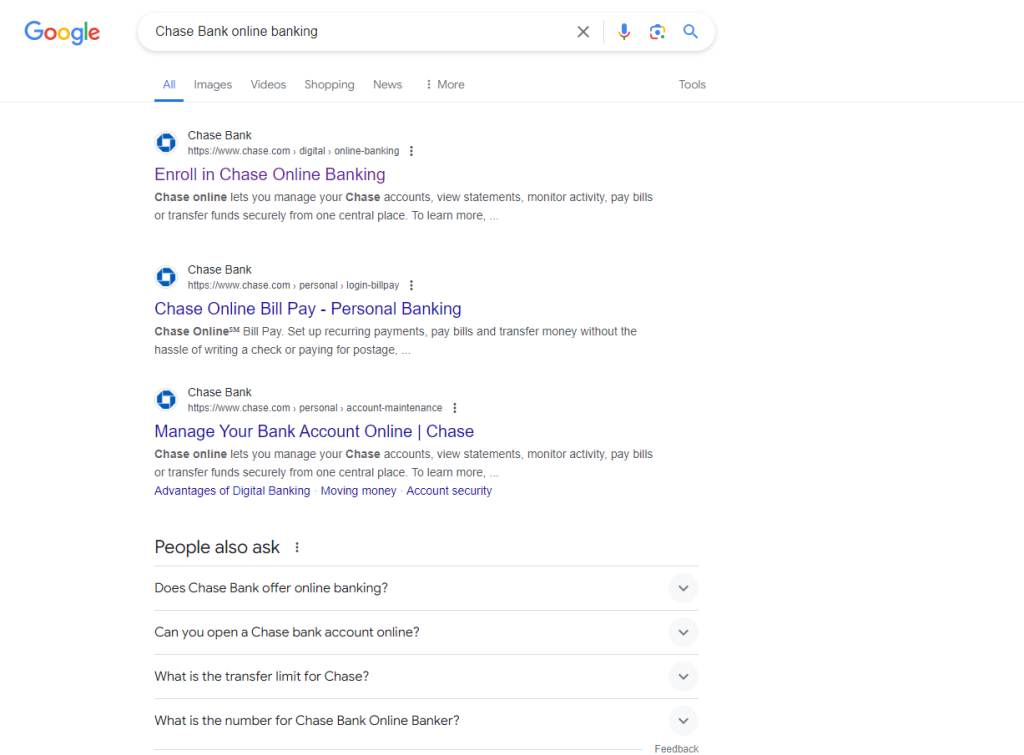
If you click on any of the results, you will be referred to a “sign up” page where you can access any of the services you have a query about.
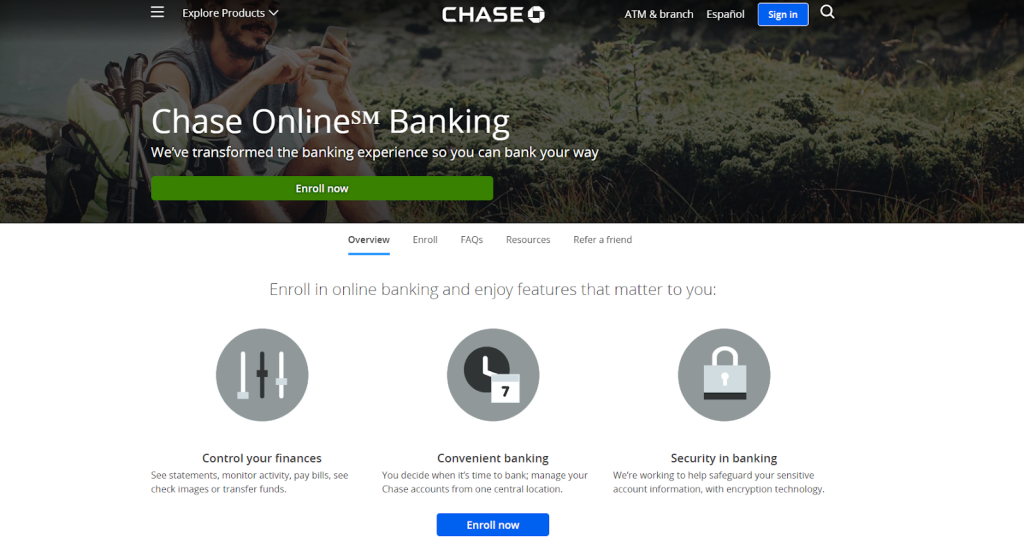
So, users with navigational intent only need landing pages that guide them to their destination quickly and effortlessly.
The ease with which a user can do this can increase brand loyalty. Users love accessing what they want as quickly as possible, and that’s what great brands provide.
3. Commercial Intent
Users with commercial search intent are in the consideration phase of a purchase. They are looking for comparison posts to learn about the features, prices, and reviews of a product or service they need.
Their queries could be “best laptops for gaming,” “Samsung Galaxy S23 review,” and “top-rated dog food brands.” The content formats to target for these queries include product comparison pages, review articles, buyer’s guides, detailed product descriptions, and “best of” lists.
Your goal with commercial search intent keywords is to provide detailed information on what the product is, the unique features of the product/service, and how your product/service is the best value for money.
This way, you can educate these users while showing how your product shines compared to others.
A user searching for “electric car comparisons” wants to weigh the pros and cons of different models. A comprehensive comparison chart detailing various electric vehicles’ range, price, features, and pros/cons would cater to this commercial intent.
For instance, it’s easy for Tesla to increase buy-ins from users willing to try a Tesla when they see a comparison like this:
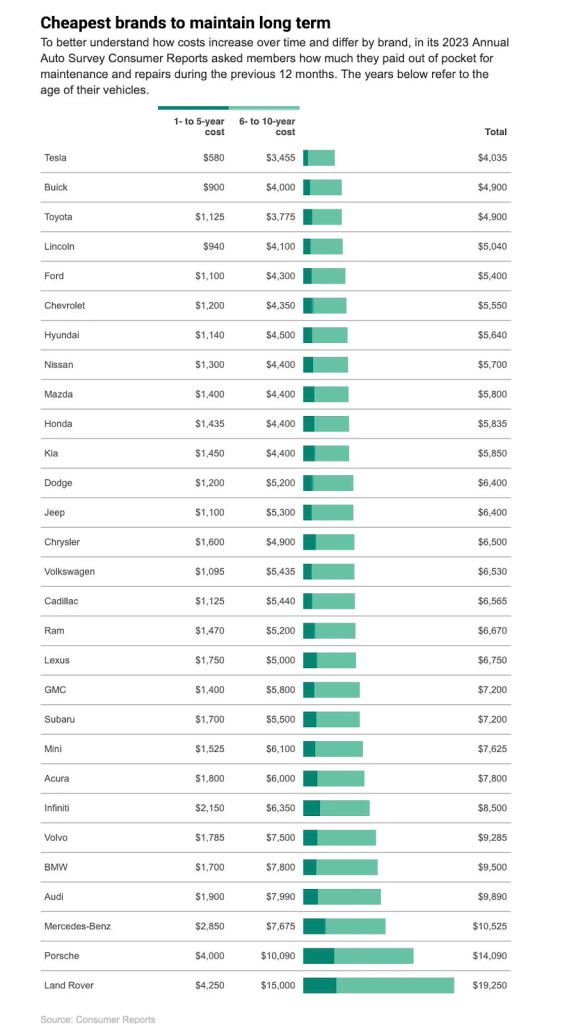
So, how does commercial search intent impact the bottom-line performance of your business or website?
It helps users during their sales journey.
Your detailed post about competitors AND how your product or services shine can help you bring these leads closer to conversion. This is because your content explores the best options in the market and shows how you’re the one they should try. If your offer best fits their needs, you have a higher chance of converting them to customers.
4. Transactional Intent
Transactional searches are the final step in the buying journey. These users are ready to buy and are looking for the easiest and most convenient way to do so. Their queries would be something like “Buy iPhone 14 Pro Max,” “Book flight to Chicago,” and “Order takeout near me.”
You should optimize your product landing pages with clear pricing and “Buy Now” buttons so users can easily get what they want. Any friction during the “checking out” process can discourage users and push them to try your competitors. (To avoid friction, conduct an SEO audit).
An example of a “company” that optimized its service page for transactional search intent is Superpath, a community for senior content marketers.
When you enter the “Superpath pro subscription” query, you’ll see a results page that shows their pricing options and how to pay.
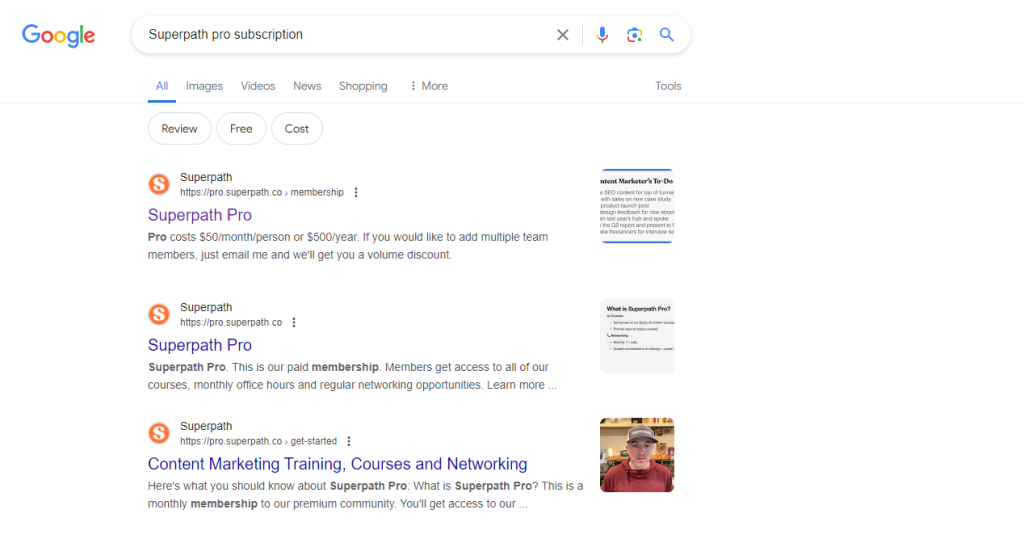
When you open the page, you”ll find details on the benefits of the subscription and a link to sign up.
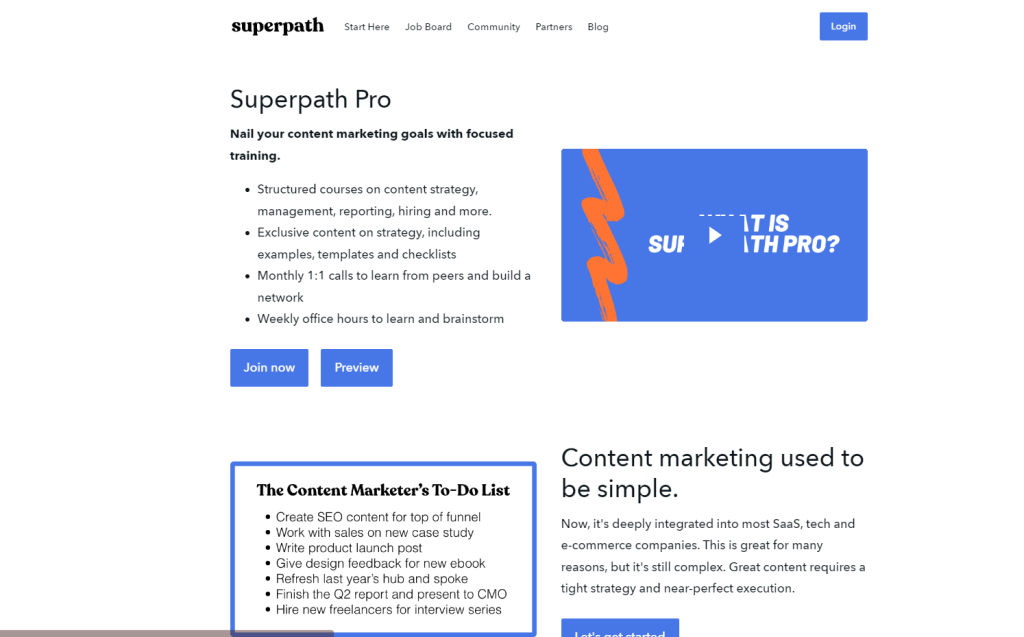
In other words, optimizing for transactional intent keywords is an opportunity to smoothen the “buying process” for your potential customers. They should easily be able to use your navigation and call-to-action buttons to take their desired actions.
Now, how do you determine search intent?
How to Determine Search Intent
We’ve established that creating content that matches search queries must go beyond optimizing for the keyword. We’ve also clarified how meeting user intent can increase website traffic and conversions. Let’s explore how to know a keyword’s search intent.
1. Listen to Voice Recordings from Sales and Customer Success
One way to uncover your customers’ (or potential customers’) real pain points is to listen to call recordings. This is an opportunity to identify common issues and create content that addresses them.
It’s also an easy way to understand their search intent when they head to Google to learn more about their queries.
For context, if you manage marketing for a fitness apparel company and hear recurring complaints about slipping leggings during workouts, you can find an angle to approach the issue while showing alternative products from your catalog that can help women work out effectively.
Since there were recurring complaints, people who haven’t heard about you likely have the challenge, too, and your content may be positioned to help. This will expose your brand to new users and build a genuine connection with new audiences who just had their problems solved by your content.
Listening to sales calls also helps you understand customers’ specific language when describing their problems or seeking solutions. You can incorporate this language into your content to make it more relatable for customers.
For example, let’s say most customers use the term “light brown” to describe their desired skin tone when speaking to the sales team of your skincare brand.
You can integrate this term in your product description, social media posts, and blog to empathize with the aspirations of your target audience, especially if your product can help them achieve the goal.
In addition to these, you can discover new content ideas from voice recordings. The questions and scenarios described on the call can inspire new content that meets user intent at the right time.
2. Use Keyword Research Tools and Conduct SERP Analysis
Keyword research tools like Ahrefs, Semrush, and Moz provide easy ways to identify the search intent of a keyword. Usually, you’ll see the search volume, keyword difficulty, and related keywords for a keyword you’ve entered in the search bar.
But they also show the search intent— here’s an example from Semrush:
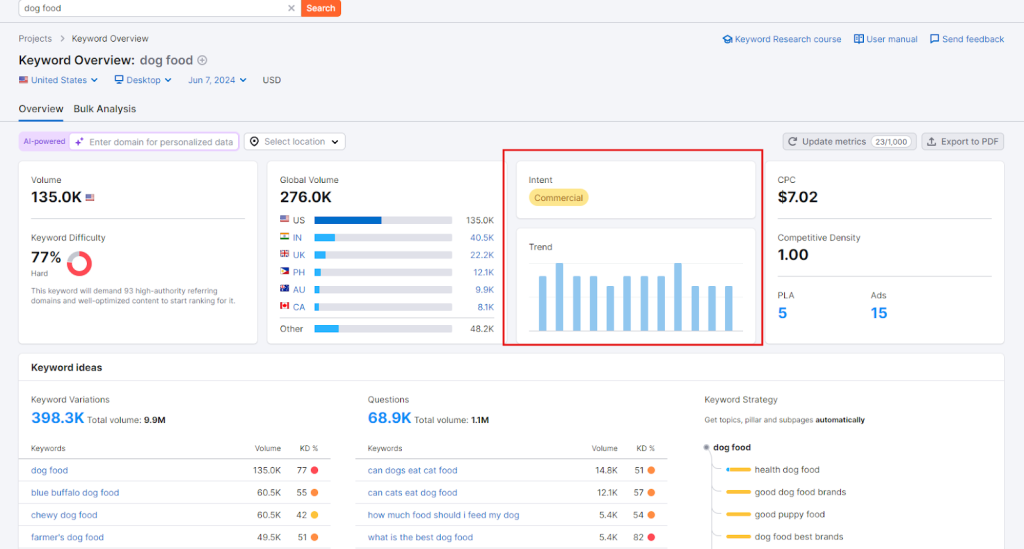
So, if you’re a dog food company that needs to rank for this keyword, you know it is a commercial search intent keyword. The next thing is to check the existing results ranking for the keyword.
If you find blog posts, comparison posts, or product pages, it means you should also create this kind of content to compete for that keyword.
So, aside from knowing that a keyword belongs to a type of user intent, analyzing search results helps you understand the kind of content that performs for the keyword.
Let’s go into more detail with the 3″Cs of content.
3. The 3 C”s of Content
What do the three Cs of content—content type, content format, and content angle—mean?
- Content Type analyzes the dominant “type” of content ranking for your targeted keyword. It provides context into the type of content you should create to meet search intent and compete with existing ranking pages. This could be blog posts, product pages, landing pages, or videos.
So, choose the type that best aligns with the user intent of your target keyword or content idea.
For context, users with informational intent are looking for blog posts or explainer videos, not products or landing pages.
- Content Format analyzes how the content is presented. Are they how-to guides, listicles, reviews, or comparison posts? Analyzing the content format helps you get more specific about the structure of the content users want to see for their query.
So, select the format that best suits the content you’re creating. For context, users with some commercial search intent keywords would prefer to see comparison posts between Brand A and Brand B rather than a landing page about how your brand is better than every other brand in the market.
- Content Angle analyzes what differentiates ranking pages from non-ranking pages for the keyword. It’s more like identifying the selling point of existing ranking pages to determine how your content can gain the searcher’s attention.
For example, to rank for the long-tail keyword “skills every SEO expert should have,” we found that each ranking page had a numbered list, e.g., ” 15 skills” from Pagetraffic and “Top 15 skills” from Uplers.
Each post also included the year “2024” to show that it’s relevant to users entering the query into search engines.
Because of these angles, we opted to go the extra mile and make our list 17-in-number and include high-quality visuals to make the information more memorable for readers in 2024.
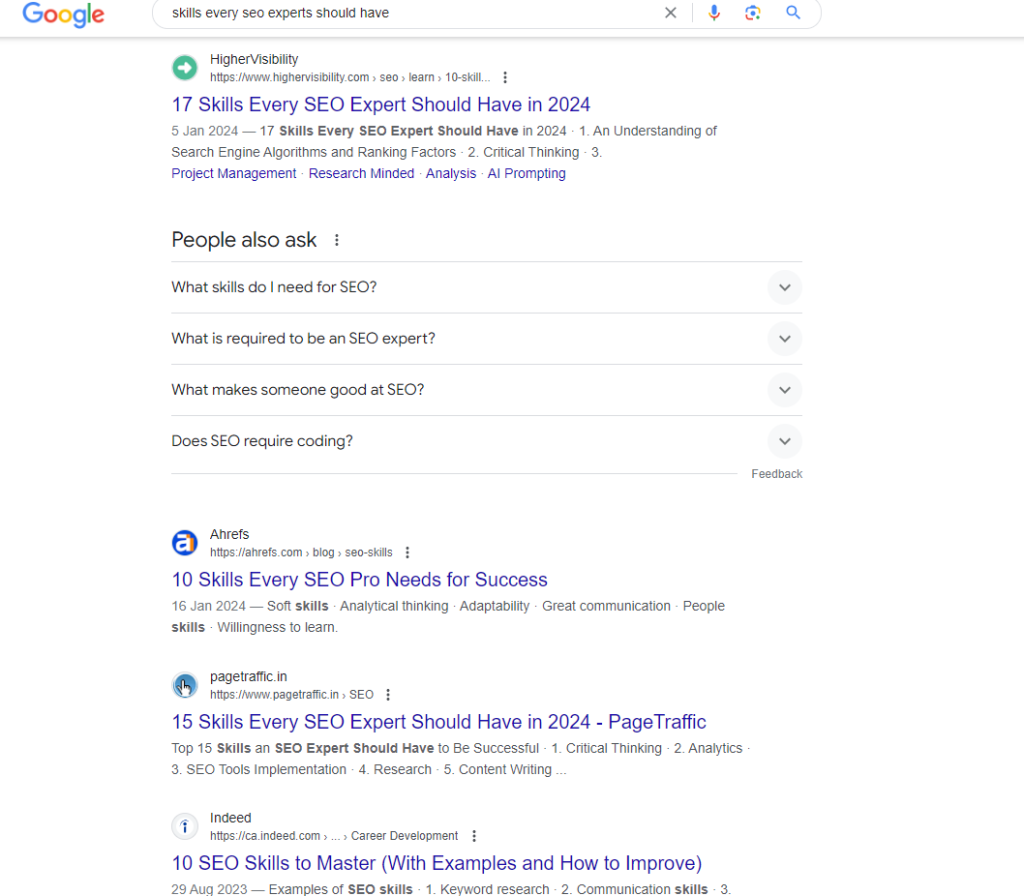
Note: The original article was published in March 2012 and updated for accuracy and comprehensiveness in January 2024. This shows that updating and refreshing your article can increase its ranking potential.
4. Pay Attention to Keyword Modifiers, People Also Ask, and Related Searches:
Keyword modifiers, people also ask (PAA), and related searches provide context into “why” users are searching for a keyword.
For example, keyword modifiers such as “best” and “review” show that the user is comparing products for specific needs. For example, “best mountain bikes” or “reviews of brand A vs. brand B.”
Meanwhile, modifiers such as “buy” and “near me” are purely transactional. Users are ready to buy, so pay attention to these modifiers because almost every keyword has one.
If your keyword doesn’t have it, use the PAA and related search boxes on Google’s SERP to understand the search intent of your keyword. Here’s how it works:
Enter the keyword on Google and scroll down to the People Also Ask and related search boxes to see other phrases/queries people are googling (related to the keyword).
For the query “healthy dog food in Minnesota,” the PAA provides insights into other queries, such as “What is the healthiest food to feed your dog?”:
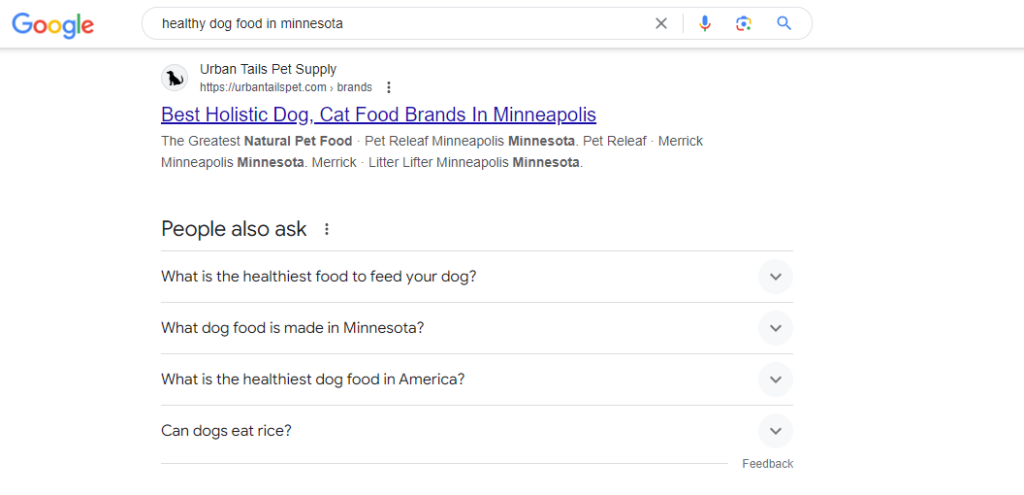
This means that in addition to targeting the query “healthy dog food in Minnesota,” the searchers for this keyword are also looking for content about the healthiest dog food to feed their dogs.
So, if you produce healthy dog food, this is an opportunity to create additional content showing some of your preferred dog food and why your production process and packaging (or any other offer) are better than your competitors.
The same goes for related searches.
You can use the related search phrases to write a separate blog post (or any ranking content type) mentioning and “selling” your product or services.
For example, people googling the query “sustainable farms in California” also ask about “best date farms in California” amongst others:
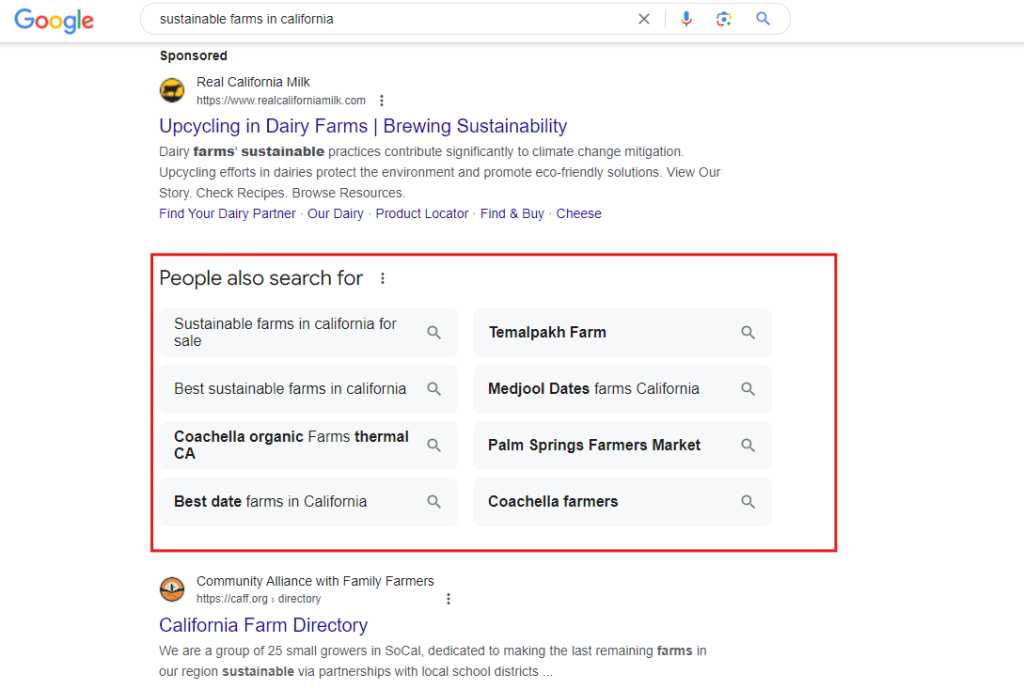
You can either use any of these phrases to add context to your article on “sustainable farms in California” OR create a separate article that addresses these phrases. However, remember that optimizing for these queries should be a part of your content strategy.
5. Optimize Your Title and Meta Tags
Your title tag is the first thing users see in search results, and it can either encourage them to click your page or not. Make the title tag compelling to improve your click-through rate (so users can see that the content aligns with their expectations).
It should be a concise and accurate 60-character text about what your article entails. It should also naturally include your primary keyword.
We rank number four for “WordPress SEO agencies” because we synced the keyword naturally and optimized the page to rank.
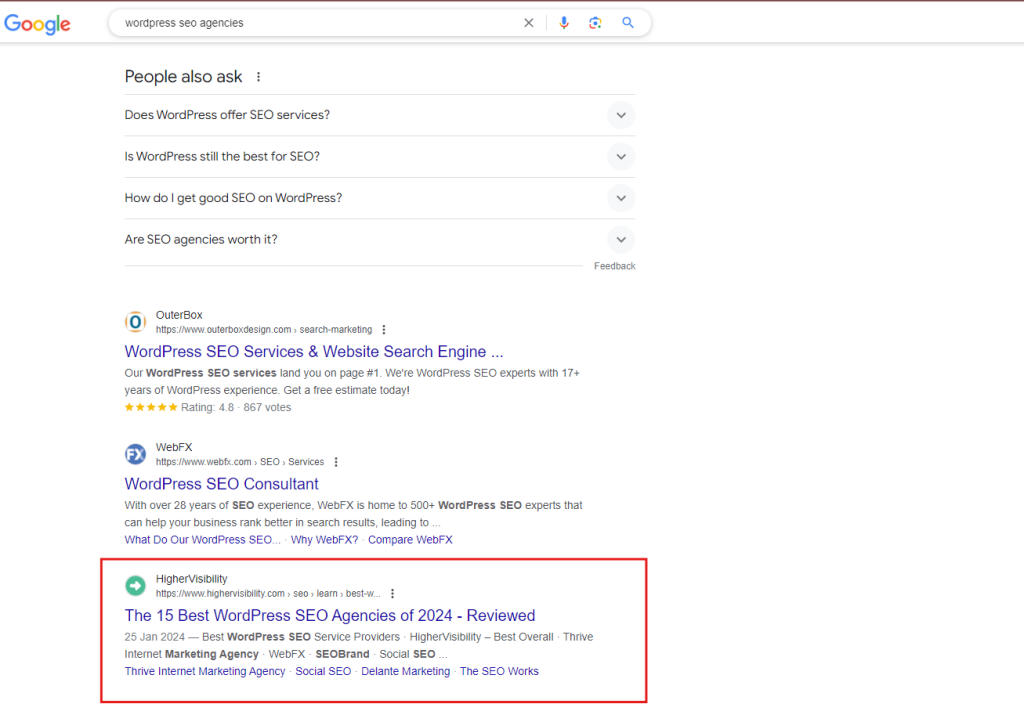
After a working title tag, let your meta description be as informative as possible. It’s the second thing users want to see as it summarizes what the page entails. For our article “SEO for Google shopping,” ranking number 1 for the keyword, users can easily see what they’ll learn from our blog post right from the results page.
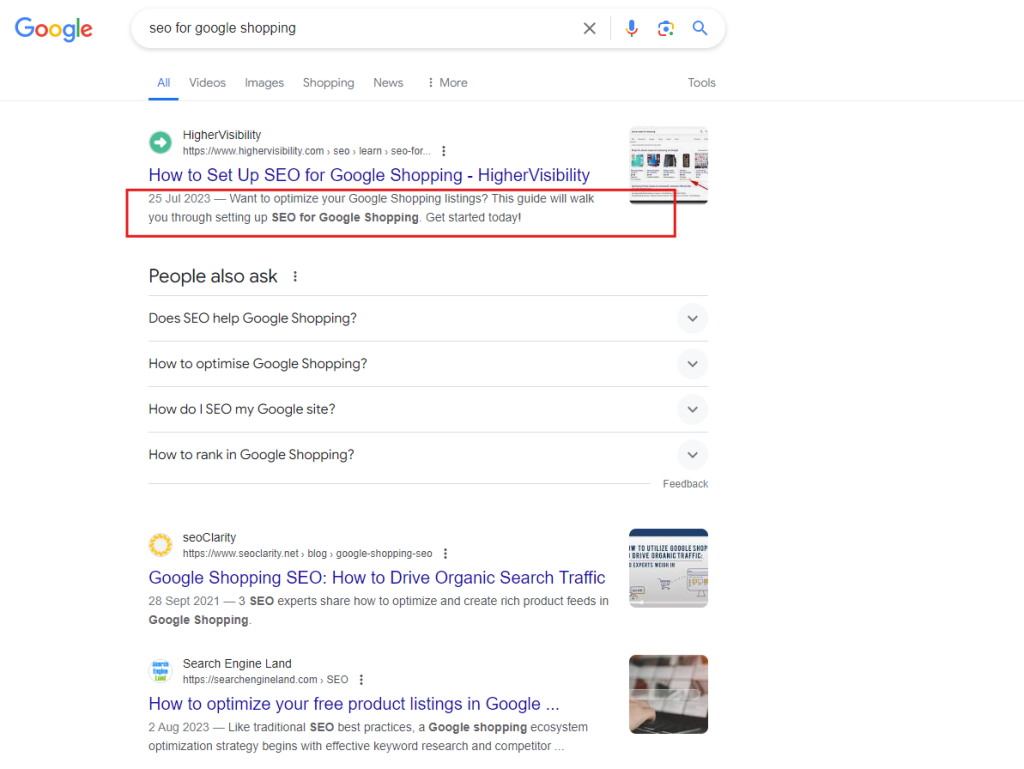
Rounding Up: Improving Search Intent Intentionally
Search intent is one of the things Google considers when ranking your web pages. When users exit your page as quickly as they open it, it signals the algorithm that your content isn’t helpful and drives down your traffic.
To avoid this, optimize your page to satisfy user intent. Make your content as helpful as possible to attract users who will take the desired action (because they trust your brand). Search engines that value content that satisfies user intent will also reward you for this.
